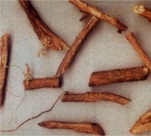Liquorice – Athimathuram

Liquorice sticks
The Liquorice plant is a legume like beans and peas that is native to southern Europe and parts of Asia. It is an herbaceous perennial plant.
The flavour of Liquorice comes mainly from a sweet tasting compound called anethole, an aromatic, unsaturated ether compound also found in anise, fennel, and several other herbs but they are not botanically relate. Much of the sweetness in Liquorice comes from glycyrrhizin, a compound 30 to 50 times sweeter than sugar and also has pharmaceutical effects.
Liquorice extract is produced by boiling Liquorice root and subsequently evaporating most of the water, and is sold both in solid and syrup form. Its active principle is glycyrrhizin. Liquorice flavour is found in a wide variety of Liquorice candies or sweets.
Liquorice Flavouring is also used in soft drinks and in some herbal infusions where it provides a sweet aftertaste. The flavour is common in medicines to disguise unpleasant flavours.
Liquorice root
The root of the plant is simply dug up, washed and chewed as a mouth freshener. Sticks of Liquorice typically have a diameter between two and ten millimeters. Although they resemble plain wooden sticks, they are soft enough to be chewed on. The root is used medicinally and is one of the most important herbs in traditional Chinese medicine
Throughout Italy unsweetened Liquorice is consumed in the form of small black pieces made only from 100% pure Liquorice extract, the taste is bitter and intense. In Chinese cuisine Liquorice is used as a culinary spice for savory foods. It is often employed to flavour broths and foods simmered in soy sauce.
Liquorice root has a very impressive list of well documented uses and is probably one of the most over-looked of all herbal remedies. It is used for many ailments including asthma, athlete's foot, baldness, body odor, bursitis, canker sores, chronic fatigue, depression, colds and flu, coughs, dandruff, emphysema, gingivitis and tooth decay, gout, heartburn, HIV, viral infections, fungal infections, ulcers, liver problems, menopause, psoriasis, shingles, sore throat, tendinitis, tuberculosis, ulcers, yeast infections, prostate enlargement and arthritis.
It has a reputation for healing ulcers and lowers stomach acid levels, relieve heartburn and indigestion and acts as a mild laxative. It can also be used for irritation, inflammation and spasm in the digestive tract. In the respiratory system it has a similarly soothing and healing action, reducing irritation and inflammation and has an expectorant effect, useful in irritating coughs, asthma and chest infections.
It has an aspirin-like action in relieving fevers and soothing pain such as headaches. Its anti-allergenic effect is very useful for hay fever, allergic rhinitis, conjunctivitis and bronchial asthma. Possibly by its action on the adrenal glands, Liquorice has the ability to improve resistance to stress. It should be thought of during times of both physical and emotional stress, after surgery or during convalescence, or when feeling tired and run down.
In Yarlpanam Athimathuram is mostly chewed by musicians and music students to improve their voice quality, it could be possible as this has soothing and healing action, reducing irritation and inflammation and has an expectorant effect, useful in irritating coughs, asthma and chest infections.





